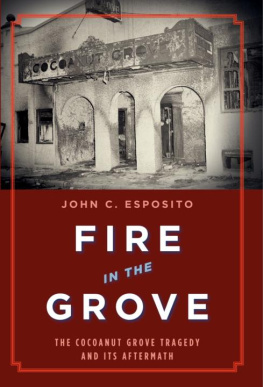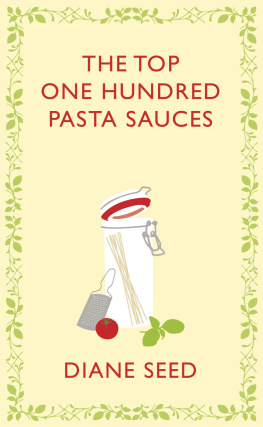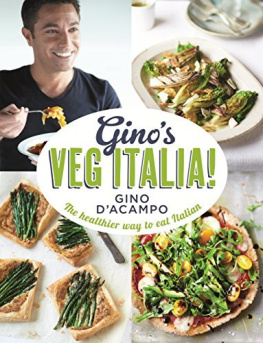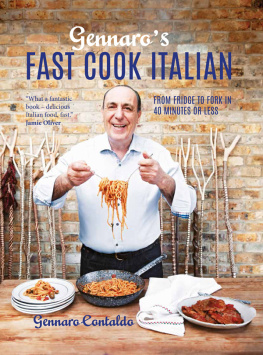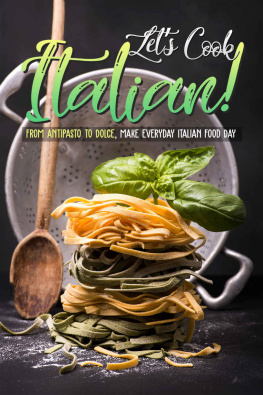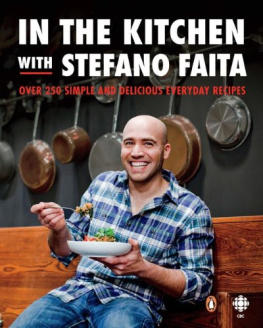CIAO ITALIA FIVE-INGREDIENT FAVORITES . Copyright 2009 by Mary Ann Esposito.
All rights reserved. Printed in the United States of America.
For information, address St. Martins Press,
75 Fifth Avenue, New York, N.Y. 10010.
Contents

Acknowledgments

A s any book author knows, writing is a lonely process, but when a book comes to fruition it is because a team of unseen, dedicated professionals pulled a work of words together in a creative and artful way. I would like to thank them. First, my editor, Michael Flamini, who has guided me in the right direction by always keeping his pulse on the trends of the day, and who is always kind enough to try the recipes that I send him. He knows food! To my agent, Jane Dystel, who believed in me and worked tirelessly on my behalf, you have my utmost respect and admiration, and I count myself lucky to be among your clients. Thank you to the staff at St. Martins Press: Vicki Lame, Jane Liddle, Leah Ransom Stewart, Kathryn Parise, Cheryl Mamaril, Jennifer Krusch, and Steve Snider. Kudos to Heath Robbins for the delicious photographs, and to Catrine Kelty for the eye-popping food styling. Who could resist trying the recipes? Thank you to my husband, Guy, always the thumbs up or thumbs down taste tester of the recipes that I cook. Your advice is always cherished. And lastly, thanks to you, dear readers, for your loyalty over the years; you keep me cooking!
Introduction

Give Me Five
W hen is less more? When you can turn just FIVE ingredients into something that is not only delicious but exciting, fun, and easy to make. I have known all along that one of the genius qualities of seasoned Italian cooks is the inherent ability to make something out of almost nothing; my grandmothers did it, my mother does it, and I am happy to say that it has rubbed off on me! Now I want to pass on what I have learned to you, so you can be a genius in the kitchen, too. Really. Read on!
The secret to achieving great-tasting Italian food today is in a word, quality. The highest-quality food products are a benchmark for Italian cooks. The brightest vegetables, the most fragrant herbs, the just-caught fish, the fruity cold-pressed olive oil, the natural grain-fed chickens, the aged artisan cheeses, the stone hearthbaked crunchy, crusted breads, and the thin-as-paper pizza, are some of the most respected Italian foods, many still made the old-fashioned way, by hand. This care and pride of workmanship is what gives Italian food its worldwide seal of approval and respect. It is no surprise then that Italian food is Americas number one favorite ethnic food.
How can we translate that kind of quality to our own kitchens? By adhering to a rule that all good Italian cooks know: less is more. Everyone loves Italian food but not everyone knows that its best not to tinker with the inherent integrity of the ingredients. Good ingredients can stand on their own with little embellishment in the seasoning and multiple ingredients department. Often just a squeeze of fresh lemon juice or a drizzle of extra-virgin olive oil is all that is needed to satisfy even the most demanding foodie. The charm lies in the fact that the ingredients are simply prepared. That is why most Italian cooks take a minimalist approach to cooking; they take their inspiration from what is local and in season. And that is why Italian food shines on its own; it is not layered, fusion, or confusion food. It is always trendy, and never tiring. Some cooks fret over the amount of time they think they need to spend prepping and cooking in order to achieve quality. They bemoan the complexity, expense, or amount of ingredients called for. It is just as easy to create a delicious dish with few ingredients as it is with an armload.
Today, we eat differently, on the run and not always together, and often, not very wisely. Yet we want unencumbered, easy-to-prepare, healthy, but delicious food. That is why this book, offering recipes with just FIVE ingredients, fits perfectly into the philosophy of Italian food. This book will deliver the results using the concept of less is more, showcasing a myriad of refreshing recipes from antipasti to dolci, using no more than FIVE ingredients. (Salt and pepper do not count.)
I have had great fun creating these recipes for you, all using ingredients readily available. And best of all, I know that the recipes will exceed your expectations, and I predict that once you try them, you will be doing high FIVEs across the kitchen table. Buon Appetito!
Five Favorite Foods
for Thought

I want you to think differently about the way you approach cooking. What if you had a limited amount of food ingredients to cook with? How would you use them? Think about where you keep food ingredients: in your cupboard or pantry, refrigerator and freezer, right? What would you consider as the five top ingredients to have in each of those locations? That will tell you a lot about the way you cook. Well, here is what I would have, and how I would use them with a little enhancement from everyday staples like salt, pepper, and flour. I can get a lot of variety from the list below by drawing on the five ingredients from the pantry, refrigerator, and freezer, proving once again that less often means more.
FIVE BASICS FROM THE PANTRY
Olive Oil
Assorted Dry Pasta
Canned Plum Tomatoes
Onions
Red Wine
Olive oil is the common denominator when it comes to Italian cooking; it is used to saut, bake, dress salads, and drizzle over fish and meats. It is also the base for creating sauces and emulsions. No Italian kitchen is without a selection of extra-virgin olive oils, meaning oil that is derived from olives that are cold pressed and have less than 1-percent acidity. There are numerous extra-virgin olive oils, all with regional characteristics depending on climate and olive type. Like wine, you need to decide what your palate prefers. In the case of extra-virgin olive oils, there are dense and fruity ones from the south of Italy and lighter and milder tasting varieties from the central and northern areas. Buy a few bottles from different regions and try them in your cooking. Olive oil leads to the next must-have in the pantry, an assortment of dried pasta from tiny soup acini di pepe to ziti. It stands to reason that if you have olive oil, onions, and tomatoes, you can make great sauces and do wonders with these ingredients in soups, stews, and rice, vegetable, and bean dishes. And red wine is as essential for cooking as it is for enjoying with your meal. Many a dish I make, from risotto to sauces for meat to poaching liquids for baked pears, plums, and cherries, get a needed boost from red wine.



